This set of Bioseparation Processes Multiple Choice Questions & Answers (MCQs) focuses on “Differential Extraction”.
1. The feed and the extracting solvent flow after one another within the extracting system in the extractor in _________
a) differential extraction
b) batch extraction
c) continuous extraction
d) staged extraction
View Answer
Explanation: The batch extraction takes place in the sets of various batches in which the feed is entered through the inlet and the raffinate is collected at the end of the extraction process. The continuous extraction takes place in the continuous entering of the feed through the inlet and continuous removal of the extract as well as the raffinate from the outlet. The staged extraction takes place within the stages of feed flow through the various stages and the collection of extract and raffinate at the end of the final stage. The differential extraction takes place in the flow of feed and the extracting solvent back to back in the extractor.
2. Which kind of equipment is used for the method of differential extraction?
a) Circular geometry
b) Rectangular geometry
c) Cylindrical geometry
d) Tubular geometry
View Answer
Explanation: The tubular geometry is generally used for the differential extraction process, this geometry works in two phase method where the phases enter from two opposite directions.
3. Which kind of arrangement is made within the equipment used for the differential extraction?
a) Flow of liquid altogether
b) Flow of liquid past the other liquid
c) Flow of liquid for collection of raffinate
d) Flow of liquid for collection of extract
View Answer
Explanation: The arrangement is in such a way that the liquid flows one after another and the respective raffinate as well as extract are separate depending on the difference of density. The arrangement ensures that there is intimate mixing of the two different phases.
4. In which condition the differential extraction process is non-equilibrium?
a) When overall extraction process is considered
b) When only one aspect of the extraction process is considered
c) When the feed part of the extraction process is considered
d) When the extract part of the extraction process is considered
View Answer
The differential extraction process is non-equilibrium when the overall extraction process is considered and the process takes place in such a way that the raffinate and the extract are not in the equilibrium to one another.
5. What is the significance of the given diagram?
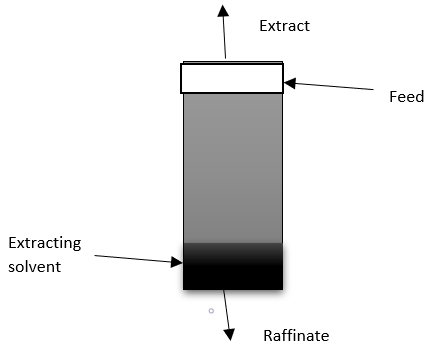
a) Extraction
b) Solvent extraction
c) Differential extraction
d) Staged extraction
View Answer
Explanation: The given diagram shows the differential extraction process in which the feed enters from the upper phase and the extracting solvent enter the extractor from the bottom phase. The raffinate is collected from the bottom and the extract is collected from the top of the extractor.
6. What is the significance of the given diagram?
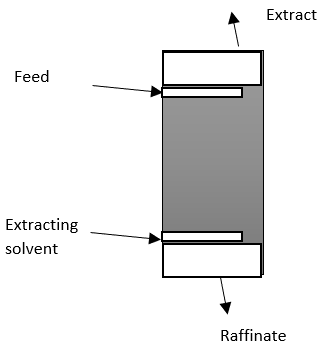
a) Spray tower differential extractor
b) Baffle plate differential extractor
c) Agitated differential extractor
d) Reciprocating disc differential extractor
View Answer
Explanation: In the given diagram the feed and the extracting solvent are entered through the spray mode and the extraction takes place in the differential process.
7. What is the significance of the given diagram?
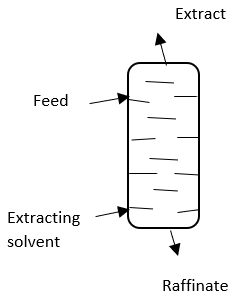
a) Spray tower differential extractor
b) Baffle plate differential extractor
c) Agitated differential extractor
d) Reciprocating disc differential extractor
View Answer
Explanation: The feed enters from the top phase and the extracting solvent enters from the bottom phase, the extraction takes place through the baffle movement within the extractor.
8. What is the significance of the given diagram?
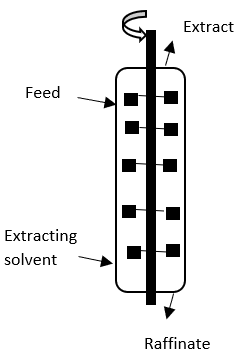
a) Spray tower differential extractor
b) Baffle plate differential extractor
c) Agitated differential extractor
d) Reciprocating disc differential extractor
View Answer
Explanation: The feed enters from the top phase of the extractor and the extract is collected from the top and the extracting solvent as well as raffinate is monitored from the bottom and the extraction takes place because of the presence of the impellers within the extractor which helps in agitation and therefore the extract and the raffinate are extracted.
9. What is the significance of the given diagram?
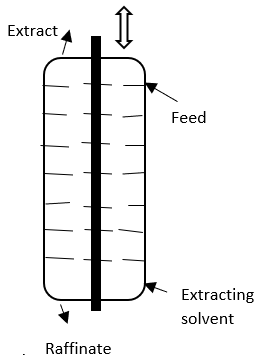
a) Spray tower differential extractor
b) Baffle plate differential extractor
c) Agitated differential extractor
d) Reciprocating disc differential extractor
View Answer
Explanation: The extractor is the combination of both the baffle plate as well as agitated differential extractor which helps in easy extraction and the extract is collected from the top and the raffinate is obtained from the bottom.
10. Which factor is responsible for the efficiency of the solute transfer in the differential extraction process?
a) Interfacial diameter
b) Interfacial circumference
c) Interfacial area
d) Interfacial surface
View Answer
Explanation: The efficiency of the solute transfer is dependent on the interfacial area of the extractor which is generated within the extractor along with the coefficient of the solute transfer of mass.
11. Within the bulk extract phase, the concentration of solute is not uniform.
a) True
b) False
View Answer
Explanation: The concentration of solute either less or more uniform but they are uniformly distributed within the bulk extract in the extractor.
12. What is the significance of the given diagram?
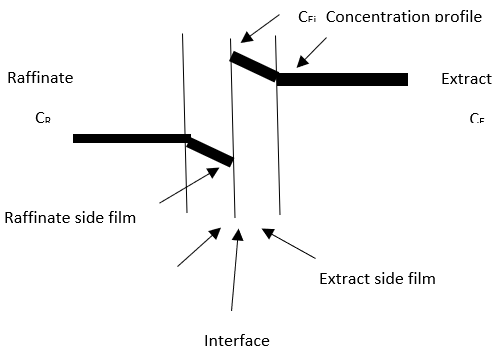
a) Solute transport
b) Solvent transport
c) Solution transport
d) Transport mechanism of extraction
View Answer
Explanation: In the stagnant films the solute concentration changes due to the solute transport within the stagnant films and the nature of such mechanism is diffusive.
13. What is the equation for solute flux across the interface?
a) NS = -kR(CR – CRi)
b) NS = kR(CR + CRi)
c) NS = kR(CR . CRi)
d) NS = kR(CR – CRi)
View Answer
Explanation: The equation for solute flux across the interface is NS = kR(CR – CRi) where, NS is the solute flux, kR is the mass transfer coefficient in raffinate side film, CR is the concentration of the raffinate, CRi is the interfacial concentration on the raffinate side.
Sanfoundry Global Education & Learning Series – Bioseparation Processes.
To practice all areas of Bioseparation Processes, here is complete set of 1000+ Multiple Choice Questions and Answers.
If you find a mistake in question / option / answer, kindly take a screenshot and email to [email protected]
